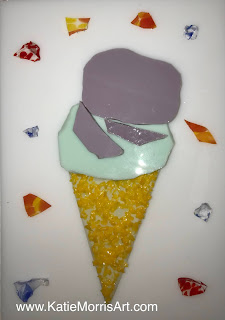This is a lesson plan I developed after hearing Preston Singletary speak at the 2019 KAEA Fall Conference. I think it’s important to remember thy we can be inspired by artist’s big ideas without trying to imitate the look of their artwork. (Full lesson plan at the end of this post!)
Katie Morris
Jackson Heights High School
Advanced Art
Lesson Title: Symbolic Fused Glass
Rationale: This lesson is intended to introduce students to glass artist Preston Singletary and the idea of using symbolism to tell stories.
Objectives
The students will participate in an inquiry based discussion of glass artist, Preston Singletary’s work.
The students will describe how Singletary used symbolism to tell stories.
The students will reflect on their own lives and make a list of stories that are important to their identities.
The students will brainstorm possible symbols to represent their identities and personal stories.
The students will work to simplify and abstract images into geometric shapes.
The students will demonstrate good craftsmanship and safe use of tools and materials when working with fused glass.
The students will design and create a fused glass design that incorporates personal symbols to tell a story.
The students will consider possibilities and make artistic choices about the function and method of display for their glass piece.
The students will reflect on and explain their work in a written artist statement.
Artist Bio
Seattle-based Preston Singletary (bass and founder of Khu.éex’) is a visual artist, glass sculptor, and teacher who renders traditional Tlingit forms in the non-traditional medium of glass. He has worked globally with Indigenous art communities and artists.
Recognized internationally as one of the leading glass artists of his generation, Singletary has artworks in dozens of museum collections. In 2004 he had a solo exhibition at the Seattle Art Museum. Singletary maintains an active schedule by teaching and lecturing internationally, including an Artist Series lecture at the NAEA 2018 convention. PBS featured his work in the 2017 Craft in America NATURE episode.
Procedure
Day 1: The teacher will lead the students in an inquiry based discussion about Preston Singletary’s work, starting with an image of his artwork and asking the students questions about what they see and think. The students will try to “read” the symbols to see if they can figure out any of the stories before watching a video of Singletary talking about his work and telling the stories of his people. Next, the teacher will ask the students to follow the design process to develop symbols that tell their personal stories/represent their identities which will be used in a fused glass project.
Symbol Design Process
Reflect on your life and make a list of stories that are important to your identity
Brainstorm possible symbols to represent your identity and personal stories
Sketch pictures of the symbols
Narrow down your symbols to the top 1-3
Simplify your symbols into geometric shapes
Day 2: The teacher will explain and demonstrate the fused glass process.
Start with a solid colored piece of glass as the base
Use scrap pieces and the glass cutting tools to create the shapes needed to represent your symbol(s)
Layer the glass pieces up to 3 thick
When satisfied, glue in place with Elmer’s glue or Aloe Vera
Frit (small pieces) can be used to add details
The glass will be heated in the kiln on top of shelf liner to a point that all the pieces are fused into one piece
After the initial fusing, the piece can be fired again to slump it into a mold, or it can stay flat
The students will finalize their design plans and begin to prepare their glass pieces.
Day 3: The students will finish their fused glass preparations and the teacher will load in the kiln.
Day 4 (after first firing): The students will prepare the work for slumping if desired.
Day 5: The students will reflect on and explain their work in a written artist statement which will be displayed with their work.
Student Examples
Standards








No comments:
Post a Comment